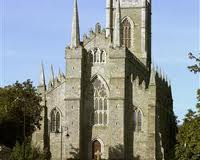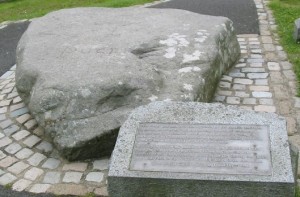St. Patrick prayed that the light would never be extinguished, and, as he prayed, the angel came to him and said: “Fear not: your apostolate shall never cease.” As he thus prayed, the glimmering light grew in brightness, and ceased not until once more all the hills and valleys of Ireland were lit up in their pristine splendour, and then the angel announced to St. Patrick: “Such shall be the abiding splendour of Divine truth in Ireland.”
At Saul (Sabhall), St. Patrick received the summons to his reward on 17 March, 493. St. Tassach administered the last sacraments to him. His remains were wrapped in the shroud woven by St. Brigid’s own hands. The bishops and clergy and faithful people from all parts crowded around his remains to pay due honor to the Father of their Faith. Some of the ancient Lives record that for several days the light of heaven shone around his bier. His remains were interred at the chieftan’s Dun or Fort two miles from Saul, where in after times arose the cathedral of Down.

Down Cathedral is a Church of Ireland cathedral. It stands on the site of a Benedictine Monastery, built in 1183. Saint Patrick’s remains are buried in the graveyard.
The Annals of the Kingdom of Ireland by the Four Masters states that by the year 438 Christianity had made such progress in Ireland that the laws were changed to agree with the Gospel. That means that in 6 years a 60 year old man was able to so change the country that even the laws were amended. St. Patrick had no printing press, no finances, few helpers and Ireland had no Roman roads to travel on.

Reputed site of burial of Saint Patrick, in the churchyard of Cathedral in Downpatrick, Nothern Ireland. The plaque reads: “According to tradition the remains of St. Patrick with those of St. Brigid and St. Columba were reinterred on this site by John De Courcy in the 12th Century thus fulfilling the prophecy that the three Saints would be buried in the same place.”
